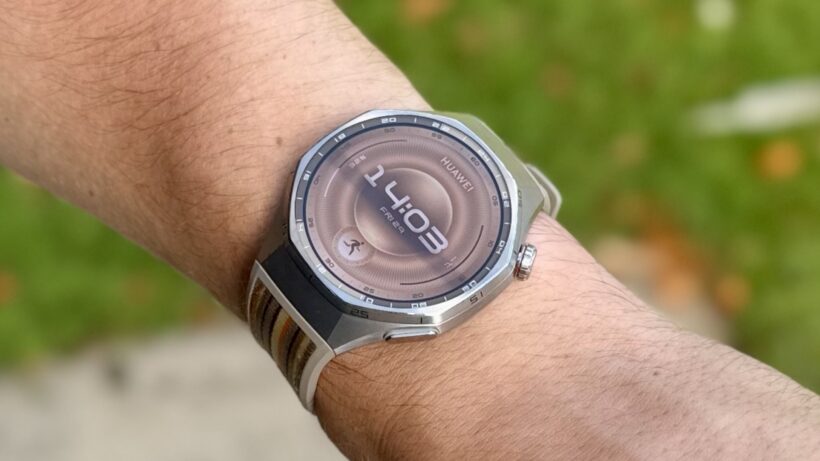The best entry yet to Huawei's sport-first smartwatch line
The Huawei Watch GT 6 Pro is a superb sports watch beautifully disguised as a premium smartwatch. It delivers elite-level heart rate, excellent GPS accuracy, outstanding battery life, and some of the most user-friendly health insights you can get. However, its smart features remain extremely limited for the price, lacking essential features such as contactless payments and a robust app ecosystem. If you prioritize fitness tracking and sophisticated design above all else, it's a brilliant choice. But for those seeking a true smartwatch experience, the compromises are significant.
Pros
- Stellar sports tracking experience
- Brighter display is gorgeous
- Over a week of AOD battery life
Cons
- Still a lack of smart features
- A few software bugs
- Only available in one case size
Huawei smartwatches have always involved a give-and-take relationship since the company was ostracised from Google and the Android platform at large.
The lack of app functionality has made its health-first, ‘classic’ smartwatches like the Huawei Watch 5 somewhat tricky to recommend to the masses. Yet, I’ve always felt that the more affordable Watch GT range hits the sweet spot.
They’ve always punched well above their weight in sports tracking (and increasingly offered the most essential health tracking features) while retaining the brand’s characteristically excellent design and build quality. In fact, the green Huawei Watch GT 4 is still my favourite-looking smartwatch to date.
But while you do generally get a few extra features for the additional outlay compared to the standard GT, these devices usually do fall short when compared to ‘true’ smartwatches like the Apple Watch Series 11 and the Samsung Galaxy Watch 8.
After a considerable amount of testing, I love the Huawei Watch GT 6 Pro for what it is—a sports watch in smartwatch clothing—but I can’t help but slightly mourn what it isn’t.
- Additional testing and images by Conor Allison, Wareable Editor
Design and display

As I mentioned before, I’ve always appreciated the injection of style Huawei has added to the Watch GT series, and the standard GT 6 is no exception. It’s a colorful device, and my favorite green version has even made a comeback, but the GT 6 Pro is a different kind of watch. It’s still eye-catching, but in a different way.
All three color options in the range (including the new rather fetching brown choice) have a more confident appearance—they aim to blend with your outfit rather than stand out as a centerpiece. The black option I have for review wouldn’t seem out of place with a suit, despite its more fitness-oriented features.
Admittedly, it’s very similar to last year’s Huawei Watch GT 5 Pro, but this time the outer bezels, which have time marks etched into them, are now slightly raised to better frame the screen.

It’s still a two-button setup, featuring a rather large rotating crown along with a push button that doesn’t protrude too much from the main body. Both are tactile to use, and the haptic feedback when you rotate the crown is satisfying, but the real highlight here is the updated display.
Screen time
The new 1.47-inch AMOLED display is 5.5% larger than what came before, and it’s definitely one of the nicest smartwatch displays I’ve used all year. There’s plenty of room for notifications and workout info to spread out, and it prevented me from incurring any mistouches during the review period.
That same display can now also reach a peak brightness level of 3000 nits, which puts it right up there with top options from Samsung and Apple. It’s just so easy to read when you’re outdoors, working in tandem with Huawei’s colourful HarmonyOS to really draw your attention, and to make watch faces pop. This feature proved particularly useful when toggling the always-on display, as the low-power version of any given watch face was still easy to read with a glance at my wrist.
Smart features

As much as I have wonderful things to say about other aspects of the device, it’s the smart features (or lack thereof) on the Watch GT 6 Pro that have really let me down. For context, I’ve gotten so used to NFC payments on my wrist, listening to music offline without my phone, and having quick access to Google Maps so that I’m not wandering around with my phone out, that the absence of all of these features has been a big disruptor to my usual routine.
What doesn’t help is that, with the watch priced around the same level as mid-range smartwatches, it competes with smart-first devices from the likes of Apple, Samsung, and Google. If you’re someone who values having access to a wide array of apps on your wrist, then you might want to pass on the GT 6 Pro altogether.
Still, it’s worth mentioning that the watch isn’t a completely barebones experience in this area.
The smart features you do get
When it comes to navigation, you can download the Petal Maps app on your smartphone (Android only, I’m afraid—sorry iPhone users). It can take you to a desired location, but it’s not as detailed as Google or Apple Maps. There is a wallet app pre-installed on the phone, but at the time of writing, there’s no way to add cards to it. So, don’t expect to use the watch to pay for a quick post-run coffee, at least during the launch period.

However, if you’re the kind of person who has never been overly concerned with smart features and just wants a simplified experience similar to what you’d find on the best fitness trackers, then you’ll get along just fine here.
You’ll still receive notifications on your wrist and be able to control music playback on your phone, which is always handy at the gym. This also includes access to your calendar and the ability to set alarms and timers. While none of it is quite as dazzling as what the competition offers, it does the job at a basic level.
Unfortunately, I noticed a few software bugs while using the watch. When paired with an Android phone, a small number of notifications didn’t reach the watch. More oddly, I encountered two instances where the fall detection triggered randomly, initiating a countdown that, if not canceled in time, would contact the authorities. Let’s hope that’s a pre-release issue and not a terminal one.
Sports tracking

While the GT line has always prioritized a lifestyle-friendly design, it has never skimped on its sports tracking credentials. In this area, the GT 6 Pro is the most capable entry yet.
Over the last few weeks of testing, we’ve logged over 50 miles of running (and around double that via indoor cycling sessions), and the overarching takeaway is that its core accuracy is excellent.
Barring the odd pre-release software niggle with GPS lock-on, its heart rate and distance tracking have proven to be right in line with our gold-standard testing devices: a Garmin Forerunner 970 (using Multi-Band GPS and paired with a Garmin HRM-Pro Plus chest strap) and the Apple Watch Ultra 2.
Huawei has placed a significant emphasis on cycling with this release—which makes sense, as the company told us these workout profiles, along with running, evenly account for around two-thirds of all workouts logged on GT devices.
New for cyclists is an innovative ‘virtual power’ feature that uses advanced algorithms to estimate your power output without needing an expensive external power meter.
Although we haven’t yet fully tested the accuracy of its FTP (Functional Threshold Power) estimates, given some inclement weather in the early British autumn, it’s a welcome addition for serious cyclists—and one we’ll hopefully be testing out more with as the months roll on.
As before, however, connecting to a power meter and performing FTP tests, or receiving estimates via other platforms, still works seamlessly.
Cycling heart rate tracking tests: Steady and ramp-up
The heart rate performance, however, has been particularly impressive across the board.
To get a baseline, I started—as we always do in our reviews—with an indoor bike session. This test is ideal because of the minimal wrist movement; it should, in theory, allow the optical sensor to shine before assessing whether it can handle tougher tests (like running outdoors and lifting in the gym).

In a one-hour, zone 2 ride, the GT 6 Pro recorded an average HR of 137bpm and a max of 159bpm, which was almost identical to the 138bpm average and 161bpm max from our chest strap. A good start, but also to be very much expected given what we’ve seen from the brand’s sports tracking in the past.

Encouragingly, it was a similar story in a more intense ramp test, where the GT 6 Pro (141bpm avg / 180bpm max) successfully kept pace with both the chest strap (142bpm avg / 180bpm max) and the Apple Watch Ultra 2 (143bpm avg / 181bpm max), demonstrating its ability to handle steady changes in intensity in a short time frame.
Running heart rate tracking & GPS tests
This strong performance continued out on the road. During a tough anaerobic sprint session, the watch did a remarkable job of tracking the rollercoaster of peaks and troughs in heart rate.
Its peak reading on each interval was consistently within 1-2BPM of the chest strap, and it accurately captured the recovery periods in between. It logged an average HR of 146bpm and a max of 176bpm, compared to the chest strap’s 147bpm average and 179bpm max.

In more stable base runs, both GPS and heart rate accuracy remained tightly matched with our Garmin setup.
On a 6.57-mile run, for example, the GT 6 Pro tracked 6.55 miles, with heart rate averages again within a single beat per minute.

Software niggles, but still a top-tier tracker
While the performance has been largely stellar, it’s also not entirely flawless.
We did experience one 10-mile run where the GPS failed to lock on for the first hour of the workout—though this did occur before a pre-release software update was rolled out. And while the GPS accuracy in our relatively open testing conditions was excellent, it remains to be seen how it would hold up in a more challenging urban environment with tall buildings.
Even so, the conclusion is clear: the GT 6 Pro delivers sports tracking performance that’s highly comparable to the very best dedicated sports watches on the market.
It successfully hides that elite capability within a design that doesn’t scream ‘sports watch’—and, ultimately, that is largely the point of this line.
Health and sleep

Just like its approach to fitness tracking, the Watch GT 6 Pro is sneakily excellent in health monitoring. The ‘Health Insights’ part of the Huawei Health app effectively highlights any trends you should know about, such as an increase in your resting heart rate or a decrease in the deep sleep you’ve been able to get.
Though the brand’s devices still lack the top-tier longitudinal and original insights you’ll find on devices like Whoop 5.0 and Oura Ring 4, it is slowly developing into a more helpful system. It’s straightforward and user-friendly, and, during testing, never felt out of sync with my current health status.
That approach also carries over to the GT 6 Pro’s sleep tracking. Even though you’ll find a more comprehensive sleep tracking setup on the more expensive Huawei Watch 5, you won’t feel like anything is missing here. The app provides a sleep score along with rankings for different sleep stages and, most importantly, a written breakdown of what it all means—what contributed to your sleep quality and, if needed, what you can do to improve it going forward.
At least when compared to smartwatches, it stands out alongside Samsung (and its animal-driven sleep tracking) as one of the most engaging sleep insights you’ll find.
Battery life

In addition to health and fitness tracking, Huawei’s watches have always run rings around the competition when it comes to battery life. Admittedly, the gap isn’t quite as wide as it used to be, thanks to major battery advancements from picks like the OnePlus Watch 3. However, by virtue of running fewer power-intensive apps, it’s miles ahead of the day-long battery life of most Apple Watch and Samsung Galaxy Watch models.
Going one step beyond the 14-day limit of the Huawei Watch GT 5 Pro, the GT 6 Pro can keep the party going for a total of 21-days with light use, or at least, that’s what Huawei claims. In my experience, you’d really have to use the watch sparingly with hardly any workouts tracked to reach that duration – you’re much more likely to hit the 14-day mark, which Huawei also says you can achieve under ‘“’ typical use’.
During the testing period, with the always-on display on, multiple workouts tracked, and wearing the watch to bed, I was able to get about nine days of use from a single charge. That’s quite impressive. I’m sure that reaching 14 days wouldn’t have been a problem if I had turned off the AOD.
Charging the device isn’t the quickest process, taking one hour and 29 minutes to go from 0% to full. However, since you rarely need to charge it, this isn’t a major issue. Plus, if you’re in a hurry, a 30-minute top-up can give you about 43% charge, which is enough to last a few days.
Should you buy the Huawei Watch GT 6 Pro?
Overall, I’ve really enjoyed my time with the Huawei Watch GT 6 Pro. Although having the watch on my wrist means giving up some smart features I love, like offline Spotify support and Google Maps connectivity, it’s still been great for tracking my health and fitness in a lot more detail.
Given that so many smartwatches throw heaps of data at their users and assume they understand it all, it’s refreshing to see Huawei’s approach of breaking it down into meaningful summaries paired with actionable advice.
Considering the GT 6 Pro’s price point, it’s tough to recommend over the Apple Watch Series 10 or Samsung Galaxy Watch 8 for most people. And with the more affordable, colorfully designed Huawei Watch GT 6 out there, it’s even harder.
However, for those looking for sports watch-like performance in a smartwatch build, it doesn’t get much better than the Watch GT 6 Pro.





